Hydrilla (Hydrilla verticillata) is one of the most aggressive submersed invasive plants in Florida waters. It can provide some benefits to fish and wildlife at low levels of coverage, but it also can have major detrimental impacts to water uses, causing substantial economic and environmental hardships.
History and Habitat
Native to southeastern Asia, hydrilla was introduced to Florida in the 1950s through the aquarium trade. It has since spread throughout Florida and continues to spread in many parts of the United States. Hydrilla has become a serious weed and is found in freshwater lakes, rivers, reservoirs, ponds, canals, and ditches.
Identification
Hydrilla grows submersed in water and is rooted to the lake bottom, although sometimes fragments break loose and survive in a free-floating state. Erect stems can grow longer than 10.6 m (35 ft) when the plant grows in deep water (Figure 1). Branching is usually sparse in deep water, but it becomes profuse near the surface. Hydrilla's small leaves (2–4 mm [0.08–0.15 in] wide, 6–20 mm [0.24–0.79 in] long) are strap-like and pointed. They grow in whorls of four to eight (rarely three) around the stem. Leaf margins are coarsely saw-toothed, and one or more sharp teeth may be present along the length of the midrib on the underside of the leaf (Figure 2). Often a small bump appears where the tooth has aborted. Common waterweed (Brazilian elodea, Egeria densa) can be misidentified as hydrilla but is uncommon in Florida. When in doubt, consult an expert for identification.
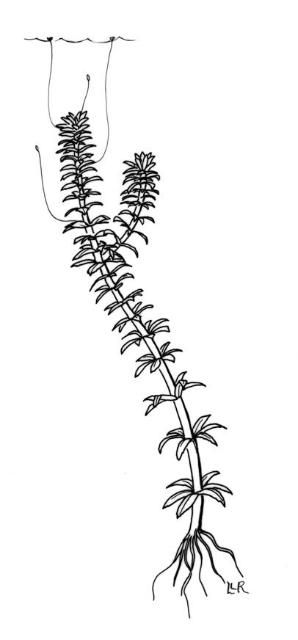
Credit: UF/IFAS Center for Aquatic and Invasive Plants
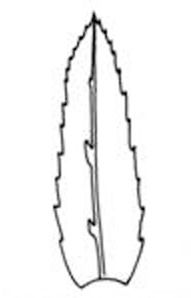
Credit: UF/IFAS Center for Aquatic and Invasive Plants
Reproduction and Distribution
Only the female dioecious (male and female flowers on different plants) biotype of hydrilla occurs in Florida. Therefore, hydrilla does not reproduce from seed in Florida. Female flowers are borne on thread like stalks and float on the water's surface (Figure 1). The flowers are solitary and have whitish petals and sepals, each about 4 mm (0.15 in) long. A key mode of reproduction and movement of hydrilla within and between lakes comes in the form of shoot fragments that readily take root and form new colonies. Hydrilla fragments are created by boaters, wildlife, and storms.
Hydrilla produces compact dormant buds called turions in leaf axils (Figure 3). It also produces tubers (Figure 4) on the end of rhizomes (underground stems) and stolons (horizontal stems). Plant fragments and stems laden with mature turions can drift throughout a water body, producing new plants. Turions are 5–8 mm (0.2–0.31 in) long, dark green, and appear to be spiny. Tubers can be found throughout sediments up to 30 cm deep. They are 5–10 mm (0.2–0.39 in) long and are off-white to yellow unless they take on darker colors from organic sediments. Hydrilla can produce millions of tubers per acre from September through March. Tubers can remain dormant for several years. They are not impacted by most management activities, and a low percentage of the tubers continues to sprout throughout the year. These attributes make hydrilla management difficult and eradication nearly impossible.
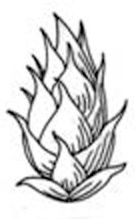
Credit: UF/IFAS Center for Aquatic and Invasive Plants
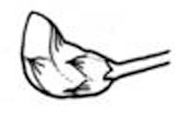
Credit: UF/IFAS Center for Aquatic and Invasive Plants
Impacts and Benefits
Hydrilla often causes serious environmental and economic impacts in Florida. It produces dense canopies that can cover the entire surface of a water body and reduce plant diversity by shading out native submersed plants. These dense canopies also provide ideal breeding environments for mosquitoes. Hydrilla may also reduce dissolved oxygen concentrations and increase fluctuations in pH and surface temperatures of the infested water body. Dense infestations can greatly impact water uses by restricting navigation and recreational activities such as boating, swimming, and fishing (Figure 5). Tourism, property values, native plant communities, water quality, fisheries, and flood control can also suffer due to dense hydrilla infestations.
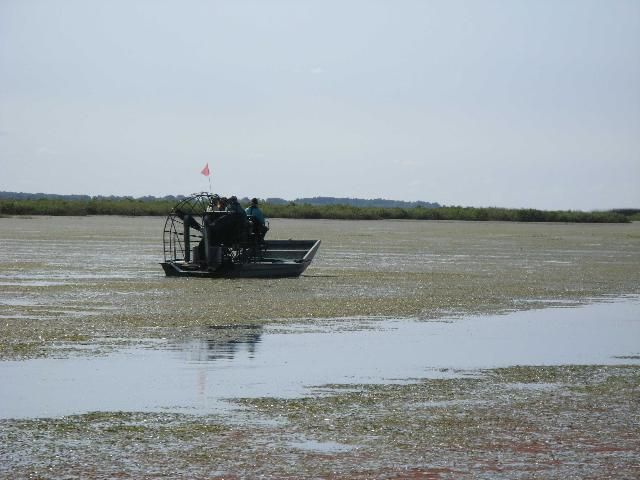
Credit: Stacia Hetrick, former UF/IFAS Extension Osceola County
In the absence of structure normally provided by a diverse underwater plant community, hydrilla can provide habitat and food resources for fish and wildlife, and it has been associated with high-quality largemouth bass populations. Low hydrilla cover also provides quality nursery habitat for juvenile fish. However, high hydrilla cover can reduce fishing because it can pose difficulties for angler access and cause fish growth rates to decline. It also represents a serious risk to fish populations due to low oxygen and potential fish kills.
Some aquatic birds and waterfowl use hydrilla as a food resource. Some migratory ducks and coots feed on hydrilla while overwintering in Florida, and many duck hunters target areas where hydrilla occurs. Alternatively, some bird species that swim through the water to forage, such as anhinga and double-crested cormorants, tend to be less abundant in areas with large amounts of hydrilla.
Hydrilla may have some recognized benefits to fish and wildlife, but maintaining low to intermediate coverage that does not impact other uses of the water body is often difficult in most aquatic systems.
Management
Responsibility
The Florida Fish and Wildlife Conservation Commission (FWC) is designated by the Florida Legislature as the lead agency responsible for coordinating and funding invasive plant management programs on public waterways in Florida. This authority is carried out under the FWC's Invasive Plant Management Section (IPMS) through the Aquatic Plant Management Program. The IPMS contracts with public agencies and private companies to manage plants in public water bodies, but other government authorities or property owners are responsible for plant management in canals, private waters, and sovereign waters that do not have public access.
Purpose
Management of hydrilla is conducted for many reasons, depending on the desired uses of the water body. For example, hydrilla is managed on many public lakes to maintain navigation and flood control and to enhance native emergent and submersed plants (such as pondweed and eelgrass). Experimental and observational data collected over the last 50 years indicate that hydrilla rarely remains static and often expands and interferes with many lake uses if not managed.
Planning
In 2011, the FWC published the agency position on hydrilla management, which states that the FWC will determine the level of hydrilla management on each public water body using a risk-based analysis that considers human safety issues, economic concerns, budgetary constraints, fish and wildlife values, and recreational use, with input from resource management partners and local stakeholders.
Hydrilla management plans are developed each year for public water bodies. Government contractors and FWC biologists draft management strategies that are reviewed by local, state, and federal agency personnel and other stakeholders who have expressed interest in invasive plant management in public waters. Reviewers then meet to establish management plans, priorities, and budgets for the ensuing year.
For aquatic plant management on the Kissimmee Chain of Lakes, a small interagency group was formed in the 1980s to aid communications between the Florida Fish and Wildlife Conservation Commission (formerly Florida Game and Freshwater Fish Commission), the Florida Department of Environmental Protection (formerly Florida Department of Natural Resources), the South Florida Water Management District, and the US Army Corps of Engineers. More than 25 years later, this group still exists—although the membership roster has increased to nearly 100 individuals from city, county, state, and federal agencies in addition to hunting and angling organizations, state universities, and a variety of citizen groups. Even though FWC is the lead entity for aquatic plant management, the creation of a Kissimmee Chain of Lakes aquatic plant management plan involves input from all these stakeholder groups.
Herbicide Stewardship
Throughout the late 1980s and 1990s, the herbicide fluridone was extensively used to manage hydrilla in Florida waters. Fluridone displayed very high efficacy, selectivity, and low toxicity to nontarget organisms. However, in 2000, researchers at several institutions, including UF/IFAS, verified what aquatic plant managers had suspected for several years. Hydrilla was developing resistance to fluridone in waters that had received repeated applications of this herbicide's active ingredient. Several populations of hydrilla, particularly in large central Florida lakes, were resistant to low fluridone concentrations. High doses of fluridone still control resistant hydrilla, but these higher concentrations affect nontarget aquatic plants and significantly increase the cost of control. Researchers agree that the best strategy for resistance management is the development of multiple tools that can be used in tank mixes or on a rotational basis. This approach has been used successfully in agricultural weed management throughout the world.
Herbicides
Herbicides are a type of pesticide made specifically to kill or inhibit the growth of plants. All pesticides must be registered for their specific use by the US Environmental Protection Agency (EPA), and they must be approved by the Florida Department of Agriculture and Consumer Services (FDACS) before they can be used in Florida. Aquatic herbicides are a type of pesticide that has been approved by the EPA to manage plant growth in aquatic systems. The label associated with each product is a legal document that describes the approved target plants, sites of application, application rates, and any restrictions on the use of water following treatment. Herbicide application techniques include helicopter, fixed-wing aircraft, boat, truck, or backpack sprayer, and they are selected based on various factors including accessibility, the size of the target treatment area, and management goals (Figure 6).
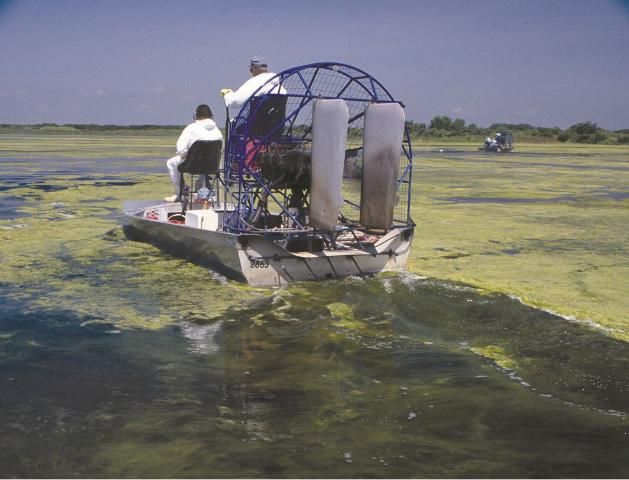
Credit: UF/IFAS Center for Aquatic and Invasive Plants
There are several herbicides used to manage hydrilla in Florida lakes. They can be classified in several ways but are separated here into contact and systemic treatments for the sake of simplicity. Contact treatments are quickly absorbed and fast-acting, and they result in very noticeable control within a few days after treatment. These include the active ingredients endothall, diquat, copper, and flumioxazin. Most systemic herbicides used for hydrilla control inhibit enzyme activity and are very slow-acting. They often require a long period of contact in the water and are best for whole-lake treatments where dilution can be minimized. They include the active ingredients fluridone, penoxsulam, imazamox, bispyribac-sodium, and topramezone. A new active ingredient, florpyrauxifen-benzyl, is also very slow-acting but inhibits several cellular processes that ultimately affect plant growth and development.
Contact Herbicides
Endothall-containing products are now widely used for hydrilla management in Florida. Endothall is a contact herbicide and requires only 12–72 hours of exposure time (depending on concentration of the herbicide in the water) to be effective. Traditional use patterns of endothall included small-scale applications for access, navigation, and treatment of new hydrilla infestations. As fluridone-resistant hydrilla became more prevalent, the switch to large-scale endothall applications was evaluated. Researchers have determined that the most effective time of year to implement large-scale hydrilla control with endothall is in late fall to early spring when water temperatures are cooler and the microbes (bacteria) that break down endothall are less active. When treating cool water, endothall breaks down at a slower rate, resulting in increased exposure of the target plants. The cooler water in the winter contains more dissolved oxygen compared to warmer water in the summer and early fall months, and the slower recovery rate of the plants allows for more effective control. Additionally, hydrilla produces tubers in the fall, so stressing the plants with herbicide during this time has the potential to decrease the amount of tuber production.
Diquat is a fast-acting contact herbicide that can be used alone but is typically used in combination with other herbicides to manage hydrilla. Diquat is generally considered non-selective, but submersed vegetation tolerance to diquat varies considerably by species. Muddy or turbid waters also inhibit diquat effectiveness because the chemical rapidly binds to suspended sediments in the water column. Unfortunately, there is not a good metric regarding water clarity and diquat use.
Flumioxazin is a fast-acting contact herbicide recently registered for use in aquatic systems in Florida. Flumioxazin is very effective on several floating plants and filamentous algae and is often tank mixed with other herbicides for emergent plant control. However, it can also be injected into the water column for hydrilla control. Flumioxazin persistence is pH-dependent. It degrades rapidly above a pH of 8.0–8.5. Optimal treatment for hydrilla occurs in the early morning, when pH is lower, and during the late winter, when hydrilla biomass is lower. Flumioxazin applied to dense infestations of hydrilla may not provide effective control.
The active ingredient copper can be used to control hydrilla. That said, due to concerns over accumulation of this naturally occurring element in lake sediments, the use of copper herbicides in public waters is permitted only when no alternative management options are available.
Systemic Herbicides
During the late 1980s and 1990s, fluridone was the most widely used herbicide for large-scale hydrilla management in Florida public waters. However, due to the evolution of fluridone-resistant hydrilla, the use of the herbicide has greatly diminished. Fluridone is usually applied as a whole-lake treatment. Fluridone is slow-acting and can provide control of hydrilla with little or no damage to other plants in the treatment area (selective). For fluridone to be effective, hydrilla must be exposed to it for a period of 45–80 days. For comparison, required exposure to endothall is only 12–36 hours. To maintain this exposure time, sequential fluridone treatments, often called "bumps," are usually applied over a period of time to ensure that a lethal concentration of the herbicide is maintained in the water column. Fluridone is still used for managing hydrilla in lakes that contain susceptible hydrilla populations. However, it is not effective in many areas where fluridone-resistant populations now occur.
Penoxsulam was registered in 2007, and it is often used in lakes where fluridone-resistant hydrilla occurs. Like fluridone, it is a slow-acting, systemic herbicide that requires a long exposure time (90–120 days) for optimum performance. Additional bump treatments may be necessary.
Bispyribac-sodium was registered in 2012 for use in aquatic systems in Florida. It is a slow-acting enzyme inhibitor that requires a long exposure time and is very effective as whole-lake treatment. The use patterns are somewhat similar to those of penoxsulam.
Imazamox is a very slow-acting enzyme inhibitor that is widely used for several emergent species but has been shown to provide some control and growth regulation of hydrilla. Applications of 50–75 ppb may suppress hydrilla growth for up to 12 weeks. That said, imazamox is not widely used for hydrilla control because more effective options are available.
Topramezone is an herbicide active ingredient registered for use in aquatic systems in Florida that assists in submersed weed control. It is slow-acting and requires a long contact time (greater than 45 days). Similar to fluridone, topramezone causes tissue bleaching in susceptible species. However, its mode of action is different from that of fluridone. It can be used in areas where fluridone resistance occurs.
Florpyrauxifen-benzyl is a slow acting auxin inhibitor. It interferes with hydrilla growth and development, inhibits new growth from meristematic tissues and causes a cascade of secondary responses including epinasty, leaf cupping, curling, and stem shattering. Florpyrauxifen-benzyl is generally applied at 30 to 40 ppb and requires an exposure time of 2 to 4 days to be effective. Recent research has indicated it is a viable option for spot treatments and whole lake treatments for hydrilla control.
Herbicide Combinations
Several resource managers rely on combinations of registered herbicides to control hydrilla. Some of the most commonly used combinations have included endothall and diquat or endothall and penoxsulam. Both of these combinations have been evaluated under large-scale field conditions. Combination treatments can help reduce reliance on a single strategy. There are several combination concepts that are still under evaluation at a small-scale level. For more information about herbicides for aquatic weed control, please visit: https://edis.ifas.ufl.edu/ag262.
Biological Control
Biological control refers to the purposeful introduction of natural enemies (i.e., insects, fish, or diseases) by scientists and environmental managers as a means to weaken and suppress invading plants. The introduction of foreign biological control agents is strictly monitored by the US Department of Agriculture's Animal and Plant Health Inspection Service (APHIS) and the Technical Advisory Group for Biological Control Agents of Weeds (TAG) and reviewed by the Department of the Interior.
To date, the grass carp is the only effective biological control agent used to manage submersed aquatic vegetation like hydrilla (Figure 7). In Florida, a permit is required by law for use and possession of grass carp, and only sterile, triploid grass carp can be used. Hydrilla control with grass carp is cost-effective, but this technique offers limited plant selectivity. The results of grass carp stocking are somewhat unpredictable, and there can be a risk of complete removal of all submersed vegetation if water bodies are heavily stocked. Grass carp are often used in ponds and small lakes where they can be contained, but they are typically not used for open systems such as Florida's large (i.e., larger than roughly 1,000 acres) public lakes. The lifespan of grass carp can exceed 15 years, and once they are introduced, they are difficult to remove. Biological control with host-specific insects has produced little success to date. Since 1987, four insect biological control agents have been intentionally released in the United States to control hydrilla. Of these insects, only the Asian hydrilla leaf mining fly is widely established and is commonly associated with hydrilla. The larvae of these insects are capable of destroying the leaves of the plant and reducing photosynthesis, but this insect has not had a significant impact on hydrilla populations. Thus, the presence of the fly has little bearing on hydrilla management decisions. For more information about hydrilla biological control agents, please visit https://edis.ifas.ufl.edu/topic_hydrilla_biological_control.
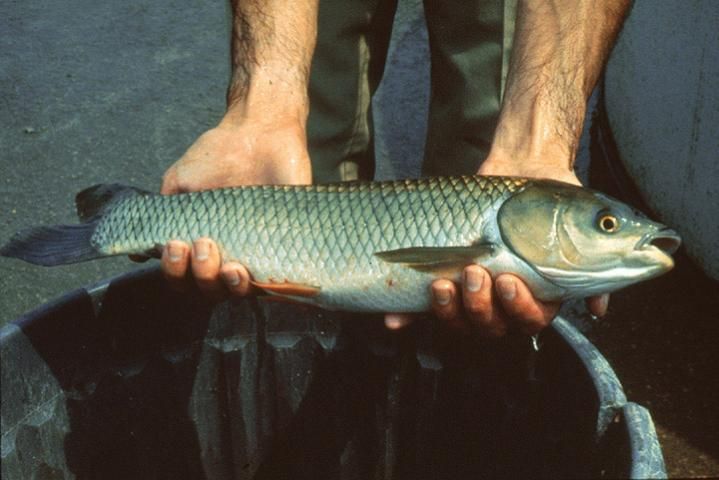
Credit: UF/IFAS Center for Aquatic and Invasive Plants
Mechanical Control
Boat harvesters are a century‐old technology able to cut, lift, and remove both submersed and emergent aquatic vegetation. Modern harvesters are typically fabricated from lightweight aluminum with hydraulically driven paddle wheels in the back and articulated cutter/conveyor tables in the front (Figure 8). These machines can cut hydrilla down to depths greater than 8 feet, then convey and offload the wet biomass onto a barge to be disposed of offshore (Figures 9–10).
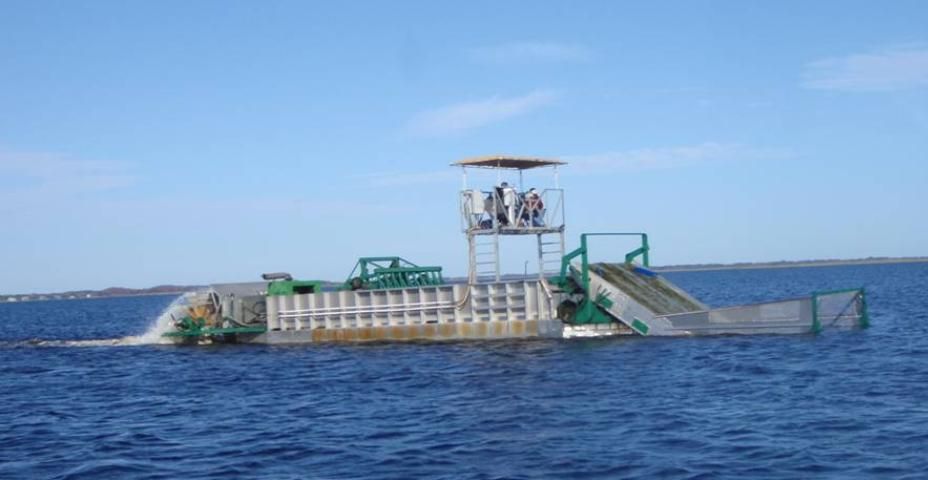
Credit: James Leary, UF/IFAS Center for Aquatic and Invasive Plants
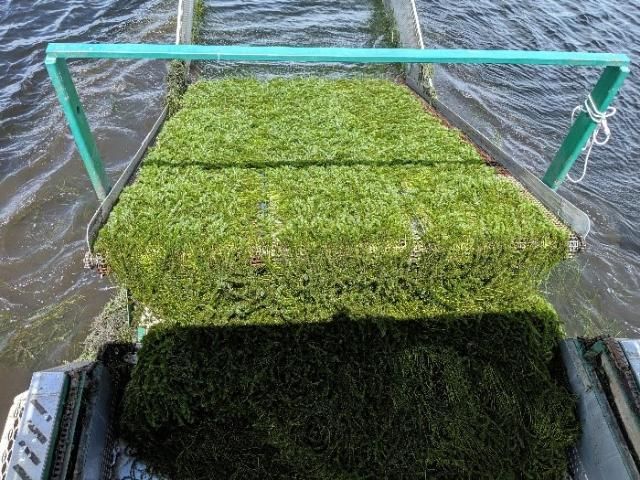
Credit: James Leary, UF/IFAS Center for Aquatic and Invasive Plants
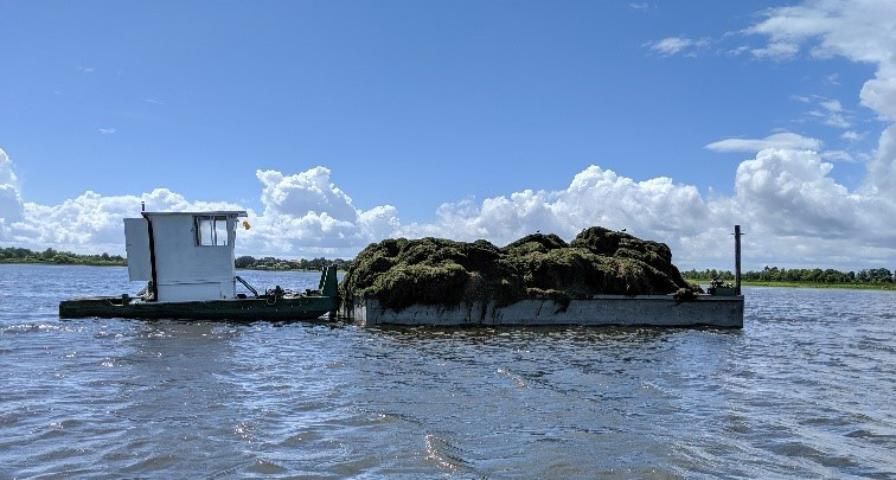
Credit: Dean Jones, UF/IFAS Extension Osceola County
Hydrilla growing to the surface can exceed 10 tons per acre of wet biomass. Boat harvesters move slowly (1–2 miles per hour) and can harvest more than 1 acre per hour. However, harvest operations are often unable to keep pace with regrowth, particularly in peak summer months where suppressive effects may only last days or weeks. Mechanical harvesting is a preferred option where herbicides are prohibited or ineffective, such as domestic water supply intakes or rapid flowing water channels, respectively. Otherwise, hydrilla harvesting on a large scale is generally regarded as less efficient and more cost‐prohibitive than chemical control.
Mechanical harvesting has the distinct advantage of removing biomass from a lake system instead of allowing it to decompose in the water column. In the future, the practice may have a significant role in lake nutrient management because several pounds of nitrogen and phosphorus can be removed with every ton of biomass. Future research will evaluate the economics and feasibility of mechanical harvesting as a complementary action to standard practice.
Research
The FWC Invasive Plant Management Section (IPMS), the Environmental Protection Agency (EPA), the US Army Engineer Research and Development Center (ERDC), and the US Department of Agriculture (USDA) are examples of agencies that currently fund hydrilla research. Much of the research focuses on chemical and biological control, but some also focuses on mechanical control, habitat quality, and hydrilla growth. Because hydrilla has shown the ability to develop herbicide-resistant plant populations, much research focuses on evaluating new and existing herbicides and combinations of herbicides for hydrilla control. Newly registered herbicides or new concepts for using herbicides to target hydrilla are typically evaluated in small water bodies and then moved to larger scale treatments if the results warrant.
Researchers continue to seek possible biological control agents such as insects and pathogens in hydrilla's native range. Current research also focuses on evaluating a naturalized midge known as the hydrilla miner, Cricotopus lebetis (Figure 11). Larvae of the hydrilla miner develop in the growing tips of hydrilla, causing branching of the plants and stunting hydrilla growth (Figure 12). Studies are being conducted to investigate temperature tolerances and host range of the insect.
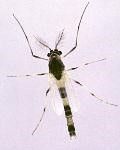
Credit: Jerry Butler, UF/IFAS Entomology and Nematology Department
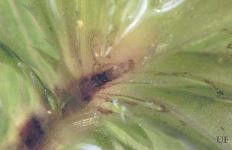
Credit: Jerry Butler, UF/IFAS Entomology and Nematology Department
Studies are also focusing on the feasibility of incorporating mechanical harvesting into large-scale management operations by further examining the potential issues related to mechanical harvesting, such as cost-effectiveness, use patterns, efficiency, and fish by-catch.